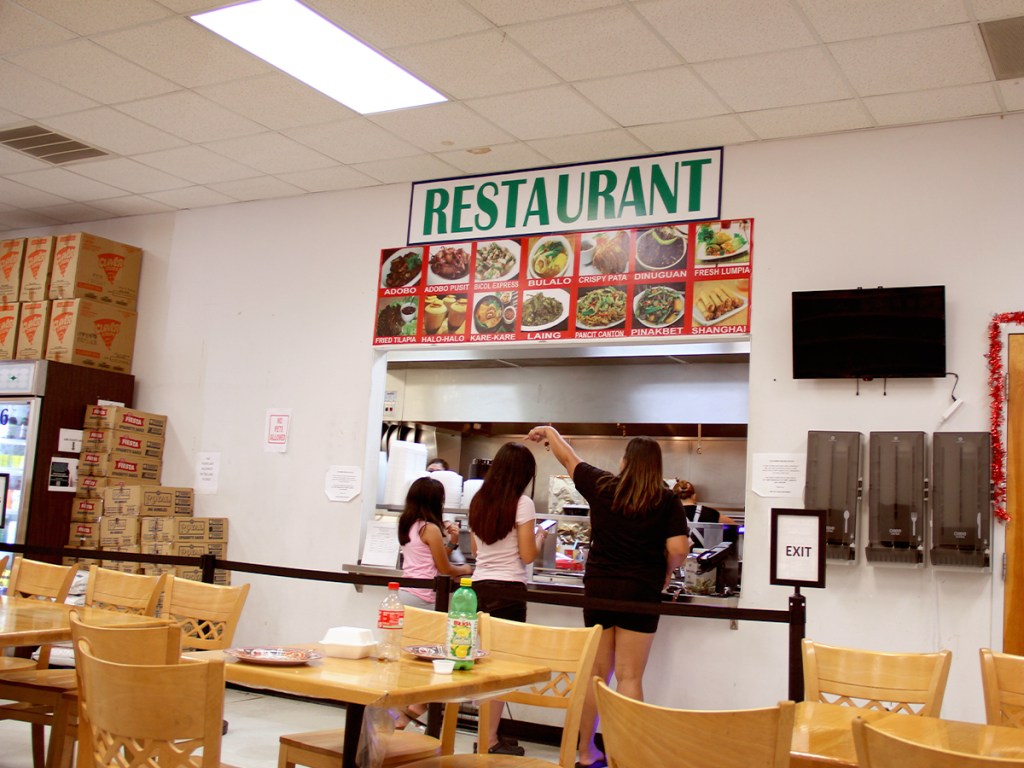Several weeks ago, a reader emailed to politely point out that my po’boy roll at Imbibe wasn’t stale, as I’d written in a previous column—it was Leidenheimer bread, an intentionally crunchy bread that the restaurant imports directly from New Orleans.
Sorry, Imbibe! In an attempt to avoid another such mishap, I did some prep work ahead of this week’s venture to Filipino Express, a Filipino restaurant tucked inside an Asian grocery store in Raleigh.
Filipino Express doesn’t have a menu listed online, so I made a list of dishes people frequently name in Yelp reviews—lumpia, pancit, adobo, and kare-kare—and researched them. I also listened to an episode of The Splendid Table about Filipino food and learned about the variety of influences on the cuisine through colonization—Spanish, Chinese, Mexican, and American—and watched a few cooking tutorials, including one on adobo, the national dish of the Philippines.
Adobo involves marinating meat or vegetables in vinegar and salt, a method that helped various food items survive the muggy Philippine climate before refrigeration existed. Adobo reflects layers of history: the Spanish named it (adobo means “marinade”), though its cooking method predated their arrival. Chinese traders later introduced soy sauce, which Filipinos came to incorporate alongside or instead of salt in the marinade.
The Capital Boulevard strip mall that houses Filipino Express is its own cultural crossroads—there’s a Dominican restaurant and barber shop, a Kung Fu academy, and a nightclub, as well as Oriental Store & Gifts, the store where Filipino Express operates. A passerby wouldn’t know there’s a restaurant inside except for the smells of garlic and vinegar coming through the vents.
I wander through the grocery aisles first. I’m delighted at how much purple stuff there is (my favorite color): açai hi-chews, ube and taro mochi, salted duck eggs dyed dark fuchsia.
In the back of the store, Filipino Express is bright and clean, with wooden tables and chairs and coolers stocked with dozens of different drinks—aloe vera juice, green tea, canned coffee. Behind a sneeze guard, metal trays hold a buffet of various dishes.
From all the reviews I’d read, I know to ask for the lunch combo, which comes with rice and two dishes. Something else I’d come across in my research was that Filipino Express is “turo turo” style, which means “point point.” You’re supposed to just point at what you want instead of ordering by name. So when a woman mixing a giant vat of purple liquid asks me for my order, I point to the Pancit Canton, a stir-fried noodle dish.
Before I can indicate a second item, the woman starts laughing and asks, “What else do you want—adobo?”
I’m not sure if she’s making a recommendation or if she’s just guessing that this is what I want because of how she’s profiled me, but either way, I feel very seen: before coming here, I jotted down my planned order in my notes app—“lunch combo with pancit and adobo.”
There are chicken and pork options for the adobo. I get pork.
Other menu options include kare-kare and dinuguan, which are stews made from various beef and pork organs and entrails, as well as fresh and fried lumpia (spring rolls), pinakbet (stewed vegetables), bulalo (beef shank soup), and crispy pata (deep-fried pig knuckles). The vat of purple liquid is for halo-halo, a dessert made with coconut milk and ube jam.
No prices are listed anywhere. The combo ends up costing $12, plus 99 cents tax. I put $2.40 in the tip jar, bringing my total to $15.39.
I notice a little station with napkins, sauces (sriracha and patis, or fish sauce), and two signs that say “take one!”—one for free kids’ tickets to a circus, and one for free pocket bibles. All the circus tickets are gone, but there are plenty of pocket Bibles, so I take one and flip through it while I wait.
A few minutes later, the cashier beckons and hands me a Styrofoam box of food.
The pancit canton tastes vaguely familiar—it takes me back to eating Cup Noodles in the cafeteria at Carolina Friends School summer camp. It mixes cabbage, celery, and carrot with two types of noodles: one with thick wheat flour and another with translucent rice noodles. The noodles are impossibly plump, imbued with so much broth that it feels like they might pop like a water balloon when I touch them with my fork.
The adobo is harder to pin down than the pancit—I recognize hints of flavors, but they merge into something new to me. The vinegar cuts through the melty pork fat, and the sauce the pork is swimming in delivers equal hits of sweetness and acid.
Both dishes have the sort of addictive mouth-watering tang where you just keep eating and eating without thinking about it. I scrape the Styrofoam clean.
Follow Staff Writer Lena Geller on Bluesky or email [email protected]. Comment on this story at [email protected].




